The AMD Ryzen 5 1600X vs Core i5 Review: Twelve Threads vs Four at $250
by Ian Cutress on April 11, 2017 9:00 AM ESTBenchmarking Performance: CPU Web Tests
One of the issues when running web-based tests is the nature of modern browsers to automatically install updates. This means any sustained period of benchmarking will invariably fall foul of the 'it's updated beyond the state of comparison' rule, especially when browsers will update if you give them half a second to think about it. Despite this, we were able to find a series of commands to create an un-updatable version of Chrome 56 for our 2017 test suite. While this means we might not be on the bleeding edge of the latest browser, it makes the scores between CPUs comparable.
SunSpider 1.0.2 [link]
The oldest web-based benchmark in this portion of our test is SunSpider. This is a very basic javascript algorithm tool, and ends up being more a measure of IPC and latency than anything else, with most high performance CPUs scoring around about the same. The basic test is looped 10 times and the average taken. We run the basic test 4 times.
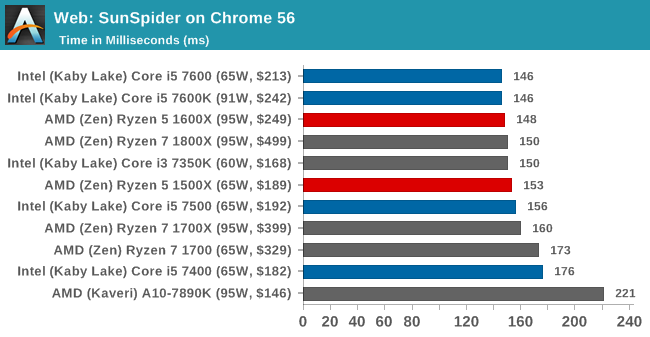
Mozilla Kraken 1.1 [link]
Kraken is another Javascript based benchmark, using the same test harness as SunSpider, but focusing on more stringent real-world use cases and libraries, such as audio processing and image filters. Again, the basic test is looped ten times, and we run the basic test four times.
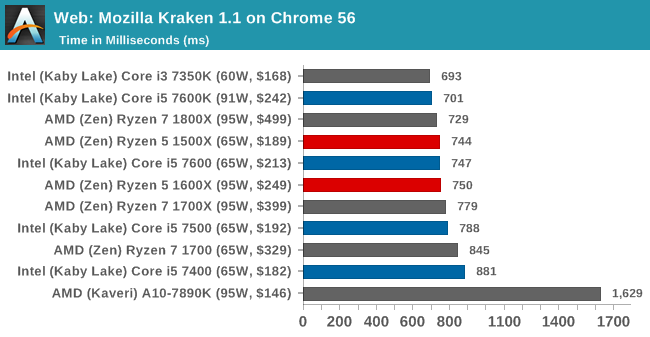
Google Octane 2.0 [link]
Along with Mozilla, as Google is a major browser developer, having peak JS performance is typically a critical asset when comparing against the other OS developers. In the same way that SunSpider is a very early JS benchmark, and Kraken is a bit newer, Octane aims to be more relevant to real workloads, especially in power constrained devices such as smartphones and tablets.
WebXPRT 2013 and 2015 [link]
While the previous three benchmarks do calculations in the background and represent a score, WebXPRT is designed to be a better interpretation of visual workloads that a professional user might have, such as browser based applications, graphing, image editing, sort/analysis, scientific analysis and financial tools. Web2013 is the older tool, superceded by Web2015, however both still are highly relevant for high-performance web applications today.
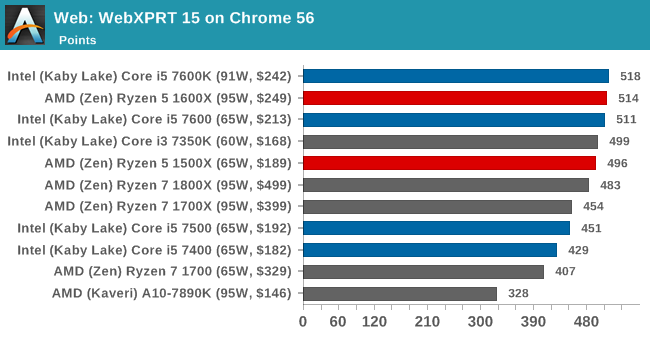


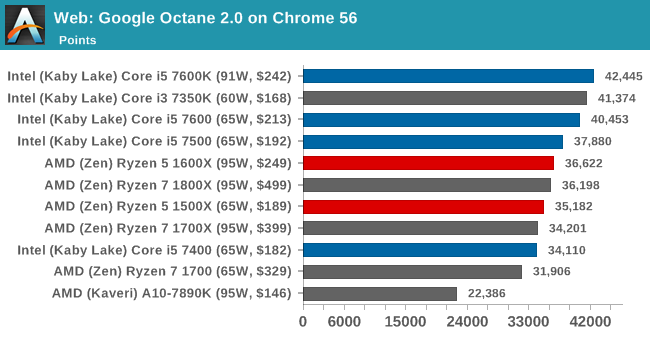
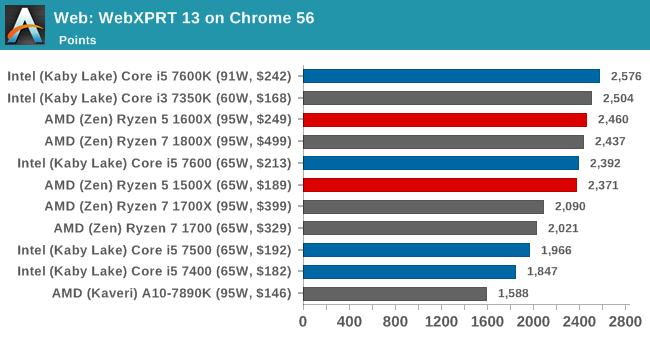








254 Comments
View All Comments
happy medium - Tuesday, April 11, 2017 - link
this review could not have purposely made the Ryzen cpu's look any better.This site is ruined.
Drumsticks - Tuesday, April 11, 2017 - link
Care to elaborate?mmegibb - Tuesday, April 11, 2017 - link
This review is consistent with what I saw with the Ryzen 7 reviews on multiple sites. In multi-threaded tests, Ryzen beats Intel because, well, it has more threads. Single thread performance lags Intel. It's up to the user to figure out price/performance for their particular needs.I'm with Drumsticks, please elaborate. This kind of drive-by comment does nothing to advance the conversation.
Anandtech's suite of benchmarks is one of the best.
fanofanand - Tuesday, April 11, 2017 - link
Not only is Anandtech's benchmark suite the best, Ian is the best CPU reviewer in the business, and quite probably in the world. I would love to know what reviewer out there has a better understanding of uArches and has the experience of a professional overclocker who pushed every component to the limits. Ian's experience and background is ideal to review CPUs, and after having read the entire thing I didn't detect even a whiff of bias. Claims of bias towards AMD at Anandtech, that's a new one to me!ddriver - Tuesday, April 11, 2017 - link
Well, the JS benchmarks are pointless really.There is much to be demanded from the benches.
Too much emphasis put on games, do really 50% of the people use computers primarily for games?
Too little on practical tests, number crunching tests are with software barely anyone uses.
People need to see performance in premiere, after effects, cubase, pro tools, vray and similar.
Bias towards AMD however is hilarious, it is quite the opposite actually.
th3ron - Tuesday, April 11, 2017 - link
You seem to forget this is a review of $250 budget cpu's. No one's going to be running pro apps like the ones you listed on cpu's like these. The number crunching test are there for comparison with the more expensive cpu's. I don't think anyones ever bought a cpu based on its Winrar score.A lot of people will uses these cpu's for gaming so lots of gaming benchmarks make sense.
ddriver - Tuesday, April 11, 2017 - link
People who use winrar most likely do not make logical considerations, because if they did, they wouldn't be using garbage like winrar.It is not a budget product, it is mid-range. And it is perfectly capable of doing a good job in content creation and such at a great value. Most of the software used in this review can barely make use of 4 threads, making such tests 66.66% pointless. Most of the tests that can actually scale to utilize the chip are software barely anyone uses or isn't even practically useful to begin with. And contrary to your beliefs, that doesn't accurately translate into performance in software that people actually use.
wolfemane - Wednesday, April 12, 2017 - link
Get off your high horse. People with midrange CPUs aren't going to use pro software? Are you really serious? I know far more people on i5s and Older AMD CPU's who use premier and after effects. My wife and I use the Adobe suite regularly. Both our systems are running 2500k's. She is photographer and has been using mid-range components for just as long. I've been using premier, after effects, and Adobe media encoder longer than she's been using Photoshop. Adobe makes it pretty cheap to use their software. When they went to a monthly rate for their entire suite with free cloud based storage for $25 a month (I think it's a bit more expensive now) we jumped on it. The cloud storage alone is worth twice that.There's no way in hell I'd drop $500+ just on a processor and Intel has made it impossible for mid to low budget builders to afford 6+ cores. But with a pretty quick 6c/12t CPU, I'll be going with AMD for our next range of CPUs, which is coming soon. Sandy bridge is getting old. Just waiting for AM4 mITX.
calken99 - Wednesday, April 12, 2017 - link
Are you really telling me that the 70,000 i5 computers in the business that I work don't use any pro applications? That's just one small corporation. Businesses will dwarf the annual sales of CPUs in comparison to the domestic market.Meteor2 - Sunday, April 16, 2017 - link
I was trying to get some numbers on this. I think consumer computers outnumber corporate by a good two to one. Not sure the average age is that different either -- most places I've seen have been holding on to their PCs for years. Core 2s abound!